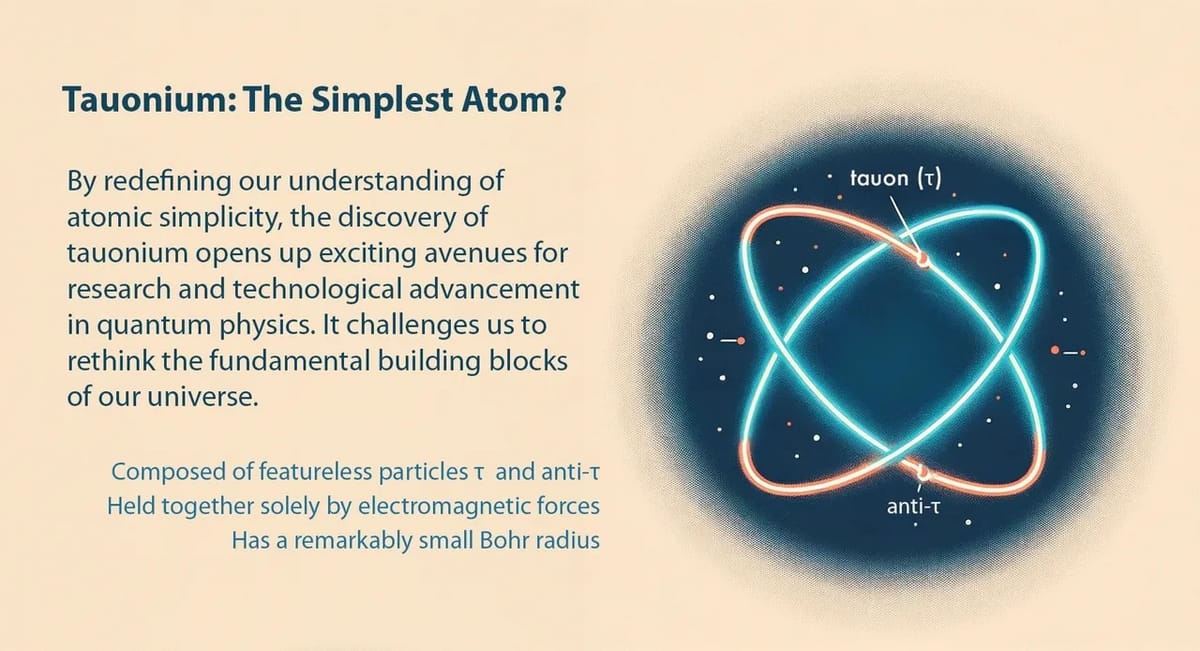When we learn quantum physics, we are often told that hydrogen is the simplest atom—a structureless electron orbiting a structured proton. Yet, recent discoveries have unveiled an even simpler type of atom: tauonium. Composed of a tauon and its antiparticle, tauonium represents a new frontier in atomic physics, challenging our understanding of simplicity in the quantum world.
The Discovery of Tauonium
Tauonium is a bound state of a tauon (τ) and its antiparticle (anti-τ), held together solely by electromagnetic interactions. This atom has a remarkably small Bohr radius of only 30.4 femtometers, approximately 1/1,741 of the Bohr radius of a hydrogen atom. The discovery was highlighted in a recent study published in Science Bulletin, which proposed a novel method for identifying tauonium using data from electron and positron colliders.
Why a Simpler Atom?
Tauonium is simpler than the hydrogen atom because it consists of elementary particles—tauons and anti-tauons—that are structureless. Unlike protons, which are made up of quarks and gluons, tauons do not have an internal structure. The interaction between the tauon and its antiparticle is purely electromagnetic, avoiding the complexities of the strong nuclear force present in hydrogen atoms. This simplicity makes tauonium an ideal system for studying fundamental principles of quantum mechanics and quantum electrodynamics (QED) at very small scales.
The Significance of Tauonium
The discovery of tauonium is significant for several reasons:
- Testing Quantum Theories: Tauonium provides a new system to test the principles of quantum mechanics and QED at smaller scales. Its unique properties offer a platform for examining the limits and accuracy of these fundamental theories.
- Precision Measurements: The proposed detection method can improve the precision of measuring the tau lepton mass to an unprecedented level of 1 keV, two orders of magnitude higher than current experiments. This enhancement is crucial for testing the electroweak sector of the Standard Model and for exploring new physics.
- Lepton Flavor Universality: Studying tauonium can provide insights into lepton flavor universality, a principle stating that all leptons should interact identically except for differences due to their masses. Deviations from this principle could indicate new physics.
- Technological and Experimental Advancements: The detection method for tauonium involves high-precision experiments at electron-positron colliders, pushing the boundaries of current experimental capabilities and fostering advancements in particle detection and accelerator technology.
- Exploring the Micro-Material World: Tauonium's extremely small Bohr radius makes it a powerful tool for exploring the micro-material world, providing new insights into the behavior of matter at the smallest scales.
By unveiling the existence of tauonium, we not only redefine our understanding of atomic simplicity but also open new avenues for research and technological advancements in the field of quantum physics. Tauonium stands as a testament to the ever-evolving nature of scientific discovery, challenging us to rethink and explore the fundamental building blocks of our universe.
Reference
- Fu, J.-H., Jia, S., Zhou, X.-Y., Zhang, Y.-J., Shen, C.-P., & Yuan, C.-Z. (2024). Novel method for identifying the heaviest QED atom. Science Bulletin. DOI: 10.1016/j.scib.2024.04.003



Member discussion: